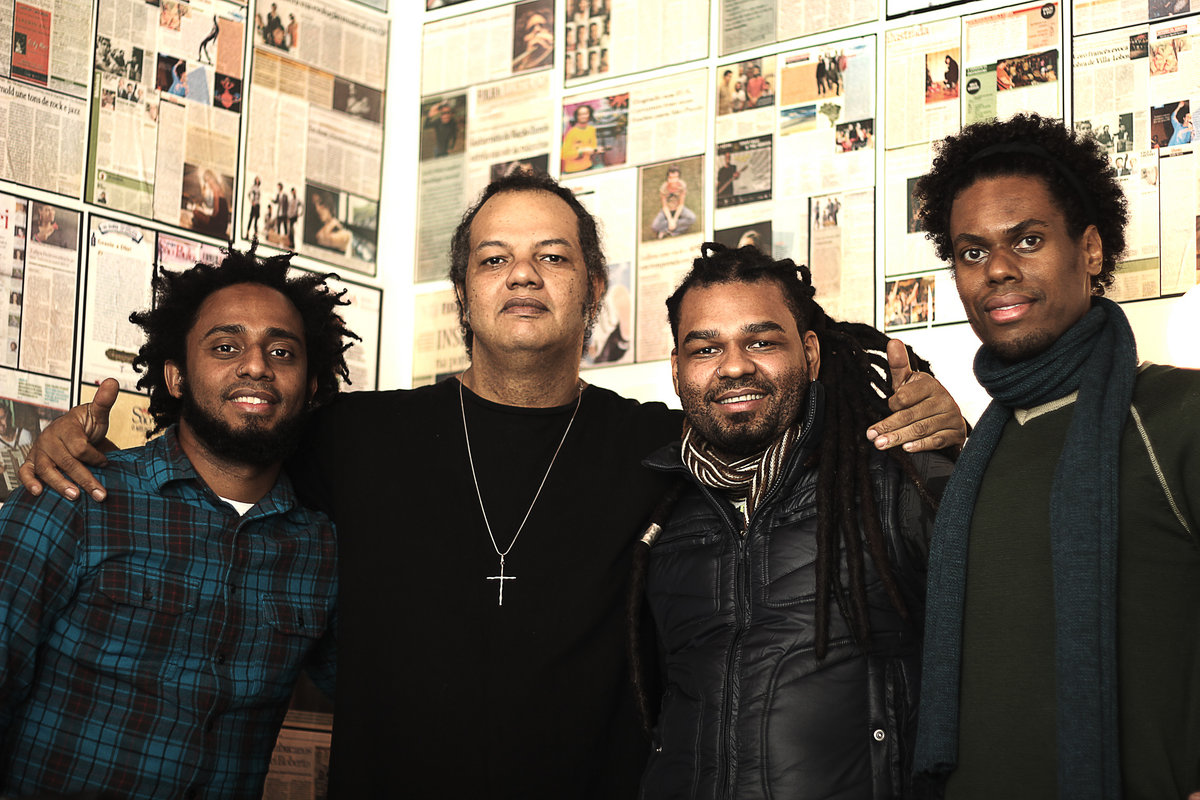 Seguimos con algo de lo mejor de Brasil con este latin Jazz / Funk / Soul brasilero. Tras la muerte del líder original, Oberdan Magalhães, en 1984, la banda se separó ya dejando una huella imborrable dentro de la escena brasilera, con sus fusiones vocales jazzísticas, funks mixturado con sambas modernas, boogies brasileros, souls afrolatinos y hasta vibraciones suaves y clásicas junto a Caetano Veloso, siempre con una fuerte carga política que en su momento unió a la escena funk negra de Río para manifestarse contra la represión, y representaba a la por entonces juventud negra brasilera, desencantada contra la dictadura militar. Pero en el 2011 sale este disco, cuando el proyecto revivió de la mano del hijo de Oberdan: William, cantante y multiinstrumentista que re-escribió las canciones de este disco y sumó un número de celebridades que aceptó sumarse al nuevo proyecto. Así llegamos a otro disco de los muchachones morochos y tirabombas, pero esta vez en una nueva generación.
Seguimos con algo de lo mejor de Brasil con este latin Jazz / Funk / Soul brasilero. Tras la muerte del líder original, Oberdan Magalhães, en 1984, la banda se separó ya dejando una huella imborrable dentro de la escena brasilera, con sus fusiones vocales jazzísticas, funks mixturado con sambas modernas, boogies brasileros, souls afrolatinos y hasta vibraciones suaves y clásicas junto a Caetano Veloso, siempre con una fuerte carga política que en su momento unió a la escena funk negra de Río para manifestarse contra la represión, y representaba a la por entonces juventud negra brasilera, desencantada contra la dictadura militar. Pero en el 2011 sale este disco, cuando el proyecto revivió de la mano del hijo de Oberdan: William, cantante y multiinstrumentista que re-escribió las canciones de este disco y sumó un número de celebridades que aceptó sumarse al nuevo proyecto. Así llegamos a otro disco de los muchachones morochos y tirabombas, pero esta vez en una nueva generación.Artista: Banda Black Rio
Álbum: Super Nova Samba Funk
Año: 2011
Género: Latin Jazz / Funk / Soul
Duración: 66:28
Nacionalidad: Brasil
Empezamos con un poco de historia...
Resulta que la banda Banda Black Rio original fue una de las grandes bandas brasileñas de las décadas del 70 y 80, fueron pioneros en mezclar la samba con el funk, y desempeñó un papel clave en la escena musical de Río en la época de la dictadura militar. Claro que todo movimiento cultural también es político y social (cosa que no me canso de relacionar en mis posteos), la Banda Black Rio original reunió en escena todo el funk negro de Río para protestar contra la represión, la industria discográfica conservadora y prensa de la clase media blanca, movilizando a la juventud brasileña negra que estaban desencantados contra la dictadura militar.
Banda Black Río se convirtió así en una de las bandas más importantes de Brasil. En los años 70 la banda mostró al mundo que la fusión del jazz y el funk junto con la samba y el ritmo brasileño, esos fueron los elementos necesarios para formar su estilo y hacer la diferencia. La banda dejó de tocar tras la muerte de uno de sus miembros (Oberdan Magalhães, fundador y líder) en 1984, pero luego revivió de la mano del hijo de Oberdan: William, cantante y multiinstrumentista que escribió o re-escribió cada canción de este disco y sumó un número de celebridades que aceptó sumarse al nuevo proyecto tirabombas (naaaa, lo de tirabombas es joda, parecen más bueno que Lassie).
En esta versión del 2011 la banda vuelve a sonar fresca, firme y segura con esa rítmica de jazz-funk con toques brasileros. Todos los que tocan aquí son grandes músicos, tocando canciones de Gilberto Gil o Caetano Veloso (entre otros íconos brasileros como Seu Jorge, Marcio Local y Elza Soares).
En esta versión del 2011 la banda vuelve a sonar fresca, firme y segura con esa rítmica de jazz-funk con toques brasileros. Todos los que tocan aquí son grandes músicos, tocando canciones de Gilberto Gil o Caetano Veloso (entre otros íconos brasileros como Seu Jorge, Marcio Local y Elza Soares).
William Magalhães formó una moderna proyección personificando el espíritu del grupo original que conformara su padre Oberdan. La filosofía de "Super Nova Samba Funk" sigue siendo la misma: la celebración de la musicalidad negra de Brasil a través de una fuerte representación lírica y su combinación única de jazz, funk, soul, samba y música negra brasilera, pero ahora con nuevos elementos que se suman a la mezcolanza negrística que aquí se aplica.
(...) En 1977, Banda Black Río lanza el primer álbum, María Fumaça por Warner Music. En 1978, la RCA lanza el álbum de BBR Gafieira Universal uno de los mejores discos jamás visto en el mercado. El tercer álbum Saci Perere se puso en marcha en 1978 y reeditado en 1980, la banda se ganó aún más fuerza en el mercado internacional. Después de un largo descanso, BBR regresó a los mercado de la musica. En 2000 lanzó el CD Movimento e este fue lanzado en Inglaterra en 2002 con el nombre Rebirth(Renacimiento). En 2011, BBR amplía su concepto y lleva a la opinión pública su 6to álbum, Super Nova Samba Funk. Un álbum audaz que mantiene las bases originales y modernizadas con la inclusión de diversos elementos. El álbum está producido por William Magalhães, hijo de Oberdan Magalhães - el líder de la banda en su primer edición. William ha sido durante más de una década, la persona a encender la llama de la banda. En los años 70 cuando el BBR vinieron, la banda tuvo una clara filosofía de la unir la samba-funk con las diferentes bases brasileñas, y con los arreglos de metales, mezclar armoniosamente todo en uno ritmo – el sonido de la Black Rio. BBR ha sido una gran referencia para el mundo de la música, artistas de renombre como MosDef ha grabado sus canciones. Con los años, tenía BBR varias configuraciones. En 2011, BBR tiene Super Nova Samba Funk, puesta en marcha por Farout una grabadora Inglesa. El álbum es la unificación de la música negra en una variedad de ritmos desde el jazz al rap. Es la unión de estilos, artistas y generaciones. El álbum muestra a su audiencia que el concepto original está vivo y modernizado y tiene el honor de tener como iconos de la música, artistas como Gilberto Gil E.Soares, Caetano Veloso y otrosMarcela Ferreira
Acá el espíritu es el mismo pero su estilo ha cambiado, ya no es una banda de funk casi instrumental e intercambiando el jazz, el rock y el soul con ritmos brasileros. Ahora lo vocal ha cobrado un importancia que antes no tenía, y la variedad de músicas que interpretan es mucho más amplia, temas de Gilberto Gil y Caetano Veloso se intercambian con hip-hop, bossa nova, pop o despliegues de soul, volviendo a vincular a Río de Janeiro con New York...
Ya dije, a mí en sí mismo no me gusta el funk, el soul o lo que estos morochos muchachones despliegan aquí, pero si reconozco que dentro de lo que hacían lo hacían muy bien, pero no por ello voy a dejar de traer estos grandes músicos a nuestros espacio.
Y sobre todo, "Super Nova Samba Funk" es la unificación de los diferentes estilos de música negra, ritmos, artistas y generaciones unidos para seguie explorando ese universo que es la música.
Y es lo último que publico de esta gente... salvo que me lo pidan.
Lo podés escuchar en Spotify:
https://open.spotify.com/intl-es/album/6w9gvgBm0LmEHkgZk5b6qb
https://open.spotify.com/intl-es/album/6w9gvgBm0LmEHkgZk5b6qb
Y acá en Bandcamp:
https://bandablackrio.bandcamp.com/album/super-nova-samba-funk
https://bandablackrio.bandcamp.com/album/super-nova-samba-funk
Saludetes...
Lista de Temas:
1. Super Nova Samba Funk (9 No Samba)
2. Louis Lane (feat. Seu Jorge y Mano Brown)
3. America Do Sul
4. Quem Vem La (feat. Marcio Local)
5. Samba Nova
6. Som Preto
7. Deixa Estar (feat. Aleh)
8. Nossa Jornada
9. It’s The Time
10. Back To The Project (feat. Flame Killer y God part 3)
11. Paname (feat. Pyroman)
12. Isabella (feat. Elza Soares y Cesar Camargo Mariano)
13. Lindos Olhos (feat. Seu Jorge y Don Pixote)
14. Final Feliz
15. Irera (feat. Gilberto Gil)
16. Aos Pes Do Redentor (feat. Caetano Veloso)
1. Super Nova Samba Funk (9 No Samba)
2. Louis Lane (feat. Seu Jorge y Mano Brown)
3. America Do Sul
4. Quem Vem La (feat. Marcio Local)
5. Samba Nova
6. Som Preto
7. Deixa Estar (feat. Aleh)
8. Nossa Jornada
9. It’s The Time
10. Back To The Project (feat. Flame Killer y God part 3)
11. Paname (feat. Pyroman)
12. Isabella (feat. Elza Soares y Cesar Camargo Mariano)
13. Lindos Olhos (feat. Seu Jorge y Don Pixote)
14. Final Feliz
15. Irera (feat. Gilberto Gil)
16. Aos Pes Do Redentor (feat. Caetano Veloso)
Alineación:
- William Magalhães / Teclados, vocales
- Aleh Ferreira / Vocales
- Thiago Silva / Batería
- TBA / Trompeta, trombón
- Andre Vasconcellos / bajo
- Isaac Negrene / guitarra
- Rodrigo Revelles / saxo
- Nilson Batata / Percusión







Comentarios
Publicar un comentario